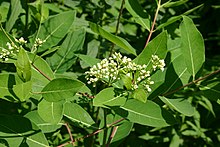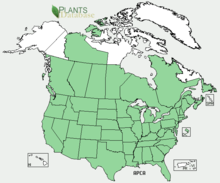Apocynum cannabinum
| Apocynum cannabinum | |
|---|---|
 |
|
| Apocynum cannabinum in flower | |
| Scientific classification | |
| Kingdom: | Plantae |
| (unranked): | Angiosperms |
| (unranked): | Eudicots |
| (unranked): | Asterids |
| Order: | Gentianales |
| Family: | Apocynaceae |
| Genus: | Apocynum |
| Species: | A. cannabinum |
| Binomial name | |
|
Apocynum cannabinum L. |
|
 |
|
| Natural range in North America | |
| Synonyms | |
|
List
|
|
Apocynum cannabinum (dogbane, amy root, hemp dogbane, prairie dogbane, Indian hemp, rheumatism root, or wild cotton) is a perennial herbaceous plant that grows throughout much of North America - in the southern half of Canada and throughout the United States. It is a poisonous plant: Apocynum means "poisonous to dogs". All parts of the plant are poisonous and can cause cardiac arrest if ingested. The cannabinum in the scientific name and the common names hemp dogbane and Indian hemp refer to its similarity to Cannabis as a fiber plant (see Hemp), rather than as a source of a psychoactive drug (see Cannabis (drug))
Although dogbane is poisonous to livestock, it likely got its name from its resemblance to a European species of the same name.
Apocynum cannabinum grows in open wooded areas, ditches, and hillsides. It is found in gravelly or sandy soil, mainly near streams in shady or moist places.
Apocynum cannabinum grows up to 2 meters/6 feet tall. The stems are reddish and contain a milky latex capable of causing skin blisters. The leaves are opposite, simple broad lanceolate, 7–15 cm long and 3–5 cm broad, entire, and smooth on top with white hairs on the underside. It flowers from July to August, has large sepals, and a five-lobed white corolla. The flowers are hermaphrodite (have both male and female organs) and are pollinated by moths and butterflies.
...
Wikipedia

